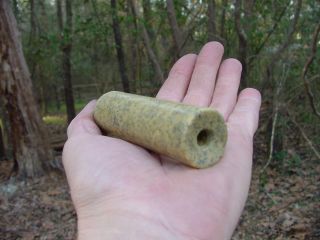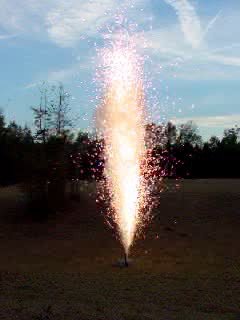

I first heard about Ti in candy propellant from Dennis Welch (www.newhorizonshobbies.com) almost two years ago. He assured me that a bit of titanium in some of my rcandy made a bright, sparkly tail. More recent conversations on the Solids and SugPro discussion lists, whetted my appetite, so I finally ordered some titanium flakes from FireFox.
They arrived a week ago amidst night classes and weekend research trips, and so sat unused and forlorn until yesterday. I heated up a little sugar syrup KN/SU and mixed some Ti in. It burned with a nice sparkly effect, especially when held up so that the burning flakes fell through the air.
So today I made a batch of better propellant, and performed two static tests using single grains in my Dr. Rocket 38-240 casing. This casing is sized well for the use of a single uninhibited grain, giving brief but strong thrust.
The propellant is a batch of rcandy made this morning using 400g food-grade KNO3, 200g cane sugar, and 70g Karo syrup. Burn rate at 1 atm is 11 seconds per inch.
After the propellant is processed to a fine texture, it is heated to softness and 50 grams of Ti flakes -20 -200 mesh mixed in. This yields a percentage of about 8%. I found it hard to mix the Ti in when cold, so I pressed the propellant flat in its baking disk, poured the Ti over it and returned it to the oven until the Ti flakes were well heated. It was easy to mix them in when hot.
Grain mold is a 4 inch section of 1-1/4 inch PVC pipe, lined with a strip of poster-board 14 inches long by 4 inches wide. This reduces the inside diameter of the PVC tubing so that the grain molded therein will fit in its casing with a little room to spare. The poster-board is in turn lined with a piece of "non-stick" paper, made by covering plain typing paper with plastic tape. This taped-paper is easy to remove from the finished grain, leaving a clean, smooth, and dry surface.
Kn ratios are kept low in these tests, partly because this is a new formula for me and I want to be conservative, partly because I am more interested in the visual effect, and have no way to determine the motors' performance. I am sure most of the Ti will be expelled from the motor and burn in air. I am equally sure that some of it will burn inside the casing, confident that it will produce higher temperature and pressure. And I am certainly sure that I don't know how much.


This grain was loaded in a Dr. Rocket 38-240 casing, lined with 3 turns
of poster-board. It fit rather nicely, rattling just a little when
the case is shaken.
Test 1
Propellant: KN/Sucrose rcandy with 8% fine Titanium flakes
Grain type: Hollow-core cylinder, uninhibited
Grain weight: 105.5g
Length: 3.55 inches
OD: 1.22 inches
Core diameter: 0.375 inches
Nozzle throat: 0.393 inches
Initial Kn ratio: 164
Final Kn ratio: 131
Ignitor: e-match with 0.3g black powder and a pinch of Mg flakes,
all sealed in masking tape.
The motor is strapped to a simple test stand out in a shallow sinkhole in the field. A couple of brave concrete blocks make sure it stays put.


Click Here for a video of this test.
(800k .mpg file, about 4 seconds of video)
Very brief burn, about 1/2 second. Nice flash!
Test 2
Now I want to test my coarser Ti. I had also purchased a pound of the -20 to +10 mesh, which contains some largish chunks. In my strand tests, this made for some large and persistent sparks.
So an additional 3 percent of this coarser Ti was added to some propellant which already contained 8% of the finer Ti.
Another similar grain is made with it, but to get a longer burning time, I inhibited the outer surface with 3 layers of aluminum-foil duct tape.
Propellant: rcandy with 11% Ti flakes, 8% fine, 3% coarse
Grain type: Hollow-core outside inhibited cylinder
Grain weight: 110.9g
Length: 3.74 inches
OD: 1.22 inches
Core diameter: 0.375 inches
Nozzle throat: 0.320 inches
Initial Kn ratio: 81
Final Kn ratio: 138
Ignitor: e-match with 0.3g black powder and a pinch of Mg flakes,
all sealed in masking tape.
Click Here for a video of this test
(800k .mpg file, 4 seconds of video)
This one came up to pressure quickly, despite the low initial Kn ratio. I wonder if the hot-burning Ti helps ignition.
It had an interesting sound, tapering off to a soft finish at the end. Predicted burn time was about a second, the sound continues for almost a full second after that. I suspect that the last part of the noise is the crackling of hundreds of Ti chunks.
Another item of interest: Note the smoke. Or lack thereof. Seems like a lot less than I recall from similar motors using plain rcandy. I am wondering if it's because I was dazzled by the brilliant light and just can't see it, or if the Ti somehow combines with the products of combustion to produce a less smoke-like exhaust? That would not have been my first guess, as the oxides of titanium are noted for their bright whiteness.
I can hardly wait to see this in a launched rocket.
Jimmy Yawn
2/23/04
jyawn@sfcc.net
www.jamesyawn.com